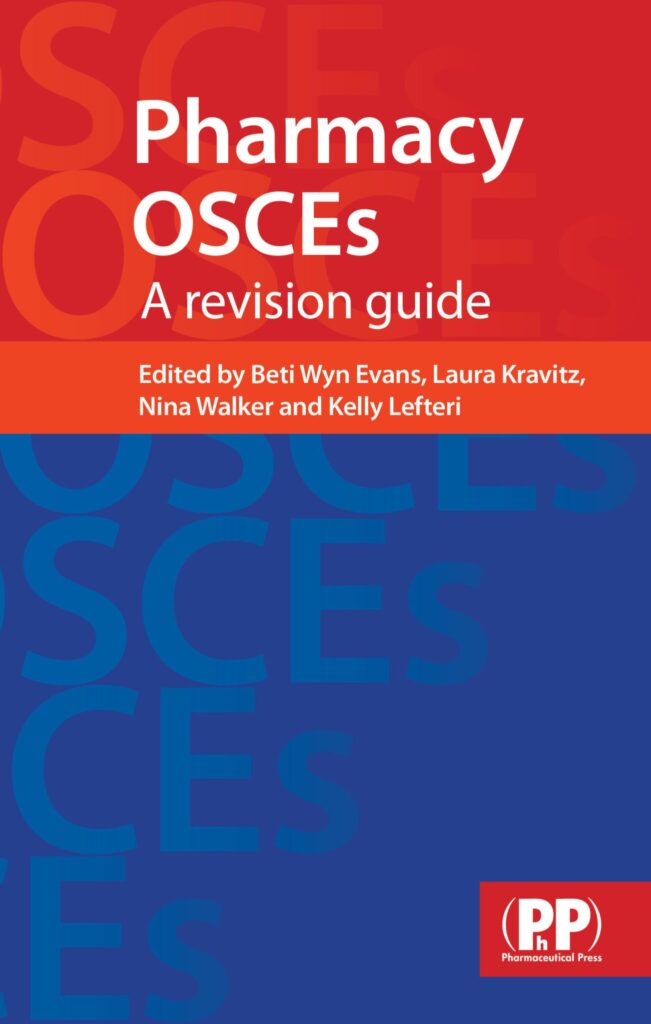
Shutterstock.com
The Objective Structured Clinical Examination (OSCE) is a form of examination that has been a feature of pharmacy education since the 1980s. For an overview of OSCEs and advice on how to prepare for them, see ‘Preparing for OSCEs in pharmacy training‘.
OSCEs are performance-based assessments, used primarily to assess clinical performance. They test not only pharmacy knowledge but also the consultation and communication skills needed to successfully treat patients and work with other healthcare professionals. To gain confidence in these skills, it is a good idea to practice consultations with friends and family.
The aim of this article is to provide a thorough overview of consultation and communication skills for pharmacy in preparation for OSCEs. This article has been adapted from Pharmacy OSCEs, published by Pharmaceutical Press.

Pharmacy OSCEs is the only pharmacy-specific OSCE revision guide that covers the key competencies that will be tested. Written in a concise and accessible way, all types of situations are covered from responding to a specific symptom to solving calculations. Over 70 scenarios read like tasks at an OSCE station and are accompanied by:
- Learning objectives;
- Questions and answers;
- Feedback and revision points;
- Key references and further reading.
Basic structure of the consultation
A consultation in which a patient presents with symptoms should be patient-centred and comprise the following five key steps1:
- Initial open question(s);
- Targeted history with ‘red flags’ (signs or symptoms that warrant referral or urgent action because they suggest significant pathology);
- Explore the patient’s thoughts and reach a shared understanding;
- Explain the management options and the shared management plan;
- Safety-netting and arranging follow-up, if appropriate.
Other types of consultation, for instance a medication review, might not require all five steps.
Initial open question(s)
Mnemonics can be used to guide your information-gathering and history-taking (see Figure). You can encourage patients to describe their illness in their own words by making optimum use of open questions and facilitation techniques. Try to avoid large numbers of closed questions asked in a set order. Hastings and Redsell (2006) use the metaphor of someone sorting post into pigeon-holes to explain how to use a mnemonic: “I let the patient tell me about the problem and as the information is given, I slot it into the appropriate place.”2
After greeting the patient and introducing yourself, encourage the patient to expand on the presenting problem/complaint. To do this:
- Use open questions (e.g. “Tell me about your headaches”; see Box 1);
- Listen attentively by:
- Looking interested (e.g. lean slightly forward and look at the patient’s face, maintain good eye contact);
- Giving the patient space to talk (allow patients to complete statements without interruption and leave space for patients to think before answering);
- Facilitate patients’ responses verbally and non-verbally.
Box 1: Open questions
Open questions:
- Can be answered in a number of ways;
- Leave the response open to respondent;
- Give the respondent a higher degree of freedom;
- Require more than one or two words;
- Allow the respondent to express opinions, attitudes, thoughts or feelings;
- May encourage the respondent to reveal information which the questioner has not anticipated;
- Often give you a better idea of a patient’s problem and how the patient perceives it.
Facilitation techniques encourage the patient to speak through verbal and non-verbal means, without directing the patient. They indicate to the patient that you are interested in their story and include the following tools: probes, pauses/silence, paraphrasing and reflection (see Box 2). If patients are allowed to talk, they usually provide lots of information by themselves. You can then place this information in the appropriate (mental) pigeonhole.
Box 2: Facilitation techniques
Probes
These include:
- Questions designed to encourage respondents to expand upon initial responses;
- Follow-up questions.
There are several types of probes:
- Non-verbal probes — a practitioner can indicate a desire for more information by raising or lowering their eyebrows, or uttering vocalisations (e.g. “Uh-huh”, “Yes”, “Go on”, “and … “, “I see”;
- Extension probes — “That’s interesting, tell me more?”; “And then what happened?”;
- Echo probes — these involve simply repeating, in an inquisitive fashion, the last few words uttered by the patient. Patient: “I’ve had this pain for a week now”. Practitioner: “A week?”
Pausing/silence
- Silent periods may make us feel uncomfortable and tempt us to rush in with another question. Try to resist this;
- Silence/pausing after a question encourages a response from the patient and prevents you from asking multiple questions at once;
- Silence/pausing following an initial response from a patient encourages the patient to continue talking (facilitation).
Paraphrasing
- Paraphrasing is restating, in your own words, what you heard the patient say;
- It focuses on content;
Patient: “The headaches started about four weeks ago, I suppose.”
Practitioner: “So you’ve been having the headaches for about a month.”
Reflecting
- Reflecting is mirroring back to patient, in verbal statements, the feeling they are communicating;
- Listen to words about feelings;
Patient: “I’ve got this terrible cough; it’s really starting to get me down.”
Practitioner: “Yes I can see you are upset.”
So that they can play their part effectively, the simulated patient you will encounter during the OSCE will have been provided with training information. This might include something like: “If the student starts the consultation with an open question, e.g. ‘Tell me about the problem’, and uses appropriate facilitation techniques, you should reveal further items of the scripted information.”
Targeted history and red flags
This part of the consultation is concerned with building a clearer picture of the presenting problem/complaint by following up on what the patient has said with systematic and structured enquiry. In other words, moving from open questions to targeted, closed questions (see Box 3).
The mnemonics referred to in the Figure may be used to assist you in doing this. The important thing to remember is that history-taking is most effective when it is discriminating and each question being asked has a purpose. Mnemonics are a useful starting point to gather information, but additional questioning may be necessary to support decision-making.
Box 3: Closed questions
With closed questions, the respondent has little choice in their responses. There are three main types of closed questions:
- Selection questions — “Is the pain dull or throbbing?”
- Yes/no questions — “Have you got a cough?”
- Identification questions — “What colour is the phlegm?”
Closed questions:
- Can be answered in one or very few words;
- Are restrictive in nature — a limited response obtained;
- Extract information rapidly and give the questioner a high degree of control over the interaction.
If overused, closed questions lead to a practitioner-centred consultation. This can result in inaccurate information being obtained and so should be avoided.
When using targeted, closed questions, you should:
- Use concise, easily understood questions;
- Avoid or explain jargon;
- Avoid using ineffective questions, such as leading, multiple and vague questions; these are unlikely to generate accurate information (see Box 4).
Box 4: Ineffective question types
Leading questions
These lead the respondent towards an expected response. They include:
- Simple questions that exert pressure on the patient to acquiesce to the practitioner’s point of view: “You’re all right, aren’t you?”
- Subtle questions that are not immediately obvious as a leading question but worded in such a way as to elicit a certain type of response: “Do you get headaches frequently, and if so, how often?” “Do you get headaches occasionally, and if so, how often?”
Leading questions should be used cautiously, since they may put patients in a defensive position, increasing the risk of inaccurate information. The two examples of subtle leading questions above have been shown to result in over-estimation and under-estimation of headaches, respectively.
Multiple questions
These are made up of two or more questions phrased as one: “Do you cough up any phlegm and is it yellow and have you tried anything for it?” Multiple questions are wasteful and confusing.
Vague questions
These leave the patient unsure how to answer: “Have you had the pain for quite a while?”
You should always clarify any answers from the patient that are vague or need amplification. For example:
- “What exactly do you mean by indigestion?”
- “Can you describe it?”
When in doubt, you should always check the information you are gathering. This may take the form of:
- Paraphrasing (see Box 2);
- Summarising (see Box 5).
Box 5: Summarising
Summarising is:
- A brief restatement of the main content and feelings of the interview;
- A check on accuracy: “Let me check to see if I understand what you have told me so far”.
It reviews data, identifies what more is needed, checks accuracy, allows the patient to clarify, indicates you are listening and ends the interview.
Throughout the information-gathering part of the consultation, you should try to pick up verbal and non-verbal cues from the patient (i.e. body language, speech, facial expression), and check out and acknowledge as appropriate. Cues are things that the patient says or does that you do not understand, or that make you unsure why they mentioned it. They are nearly always hiding important and relevant information:
- Patient: “I’ve got this terrible cold that’s going around, and what with my test and everything I thought I’d better get something for it”;
- Pharmacist: “You mentioned a test … ?”;
- Patient: “Well, you see I’ve got my driving test in a couple of days and …”.
Closed questions can also help you identify ‘red flags’, which are signs or symptoms that warrant referral or urgent action because they suggest significant pathology. They should not be missed or neglected. Examples include: haemoptysis (coughing up of blood) in a patient who presents with cough; difficulty swallowing in a patient presenting with dyspepsia; and visual disturbances associated with a headache.
Reaching a shared understanding
In this part of the consultation, you need to translate your understanding of something into words and concepts patients will understand. This involves taking the patient’s existing understanding and moving it towards your understanding — reaching a shared understanding.
During the information-gathering part of the consultation, you will generate your own ideas (e.g. likely cause of the patient’s problem/symptom), concerns (e.g. patient has red flags) and expectations (e.g. patient will get better without needing any medication). The patient is likely to have come to the pharmacy with their own ideas about their problem, which will have been informed by past experience, discussion with friends or relatives, articles in the newspaper or information on the internet or television. They may have concerns about the problem and almost certainly will have definite expectations about what they want from the pharmacist.
Sometimes the expectations of the patient will be clear very early on in the consultation; for example, they have a cough and want a cough suppressant. At other times, you may need to actively explore expectations with the patient. It is important to recognise the importance of exploring the patient’s ideas, concerns and expectations in order for you to know the patient’s perspective and to achieve a true, shared understanding. Without this, patients are less likely to accept and follow your advice and management plan. A patient who comes to the pharmacy with a cough and expects to leave with a cough medicine — and whose cough you attribute to being a side-effect of an ACE inhibitor — is unlikely to accept your referral to her GP unless you are able to reach a shared understanding of the problem.
Shared management plan
At some stage in most consultations you will need to give information to patients, such as explaining the management options and how to take or use prescribed medication.
Explaining is probably the most difficult of the communication tasks. It involves:
- What information to give the patient — the content;
- How to give the information — the process.
When explaining, to often we focus on the content rather than on the process. There are three essential stages to explaining:
- Planning;
- Presenting;
- Checking understanding.
In most consultations, you will need to give information to patients. You may need to explain:
- Your assessment of a patient’s problem (what’s wrong with them);
- What you expect to happen and what they should do if it does not;
- The management options and plan;
- The expected outcome of the management plan;
- The safe and effective use of medication.
Planning is crucial to effective explaining and involves deciding how much and the type of information to provide. There are three steps that are important when planning an explanation:
- Decide what you are going to explain;
- Pick out the key points of your explanation. These should be kept to the minimum necessary (no more than four, if possible);
- Work from the known to the unknown. This point is frequently overlooked and too much time is then spent explaining things people already know or, at the other extreme, talking over their heads. Find out as much as possible about what the patient already knows.
Find out what the patient knows and would like to know. Around 80% of patients want more information and around 20% avoid information. Ask the patient what he or she would like to know (e.g. “There’s a lot more information that I’d be happy to share with you about migraine and the drugs used to treat it. Some patients like to know a lot and some prefer to keep it to a minimum. How much information would you like?”).
Where there is a lot of information to provide to the patient, it is helpful to give information in small chunks (of no more than four key points). Then pause and check for understanding before proceeding. This is often referred to as ‘chunking and checking’.
Presentation — the process
Studies of patients’ recall of their doctors’ and pharmacists’ explanations suggest that only a very small portion of the delivered information is retained. Building the following educational strategies into your presentation will help your patient understand and remember essential information.
Set aside enough time
Time is a precious commodity for the pharmacist and the patient. However, an explanation that is hurried is likely to be ineffective. Therefore, set aside enough time.
Keep the message simple and brief
Complexity in an explanation makes for greater difficulty in understanding it. The patient will inevitably take in only parts of the explanation and this can be a recipe for disaster. As a result, explanations should be kept simple. Brevity is essential so that patients can easily recall and understand the explanation given.
Be clear and fluent
Clear explanations use appropriate language and are specific. If you must use technical terms, explain their meaning. The message should also be specific, avoiding vague terms (such as “drink plenty of water”) and expressions. Pace your explanation. It should be fluent and contain pauses. Lack of fluency is often caused by trying to put too many ideas or facts across in a single sentence. Plan your explanation and use sentences that are short and to the point, with pauses in between them. Try to mark out key parts or stages of your explanation (chunking) with short pauses.
In summary, avoid saying too much, too quickly. Pausing not only gives the patient a chance to reflect on what you’ve said so far, it also allows you time to collect and organise your thoughts. Furthermore, lack of fluency in speech may be interpreted by a patient as a lack of knowledge.
Focus on the important points
Base your explanation on realistic expectations of what your patient will understand, depending on their previous knowledge, the complexity of the material and the time available. To cover a few essentials well is the goal for complex explanations. When you have to present a large amount of information, lead off with the important points, since your initial message is often best retained.
Categorise information
This is especially useful when you are trying to communicate a complex message. It helps the patient to organise new knowledge and remember it. Categorisation involves telling the patient what categories of information are to be provided, then present the information category by category.
For example: “Now I am going to tell you how omeprazole works, what its side effects are, what drugs interact with it, and how it should be taken.”
Summarise information
Having given an explanation, bring the important points together in a summary. A summary is essential for effective explaining. It directs the listener’s attention to the most important or essential information. The beginning and end of an explanation are more likely to be remembered than items in the middle, so the middle will need to be given emphasis.
Emphasis can be attached to important items of information verbally using markers. Markers precede the part of the message which is being emphasised, such as sequence markers (e.g. ‘first’, ‘second’, ‘third’) or importance markers (e.g. “this is really important”). Non-verbal emphasis is added to an explanation through change in volume and tone and via gestures and movement (body language). Repeat and emphasise important points. The repetition of important pieces of information helps in the acquisition and retention of knowledge.
Be encouraging
Patients learn better when they are given praise. Recognise their strengths and acknowledge their efforts. Be enthusiastic.
Make an effective conclusion
Your explanation should also come to an effective conclusion. Choose a few important points to repeat and emphasise (e.g. “So just to recap — make sure that you use separate face cloth and towel, put one drop into each eye every two hours for the next two days and then every four hours for a further five days, and come back and see me if things don’t start to improve in five days or if they get worse”). You should also ask the patient if there is any other information they would like (e.g. “Are there any other questions you would like me to answer or any points I haven’t covered?”).
The conclusion is also the time for a brief message that motivates the patient (e.g. “I hope that you are feeling better soon”).
Checking understanding
The third feature of effective explaining is to obtain feedback on whether your explanation has been adequately understood. It is this checking understanding that some pharmacists find most difficult.
There are a number of ways of checking that your explanation has been understood. You may observe the patient’s non-verbal behaviour, such as raised eyebrows or blank looks. Other ways of checking understanding include asking questions, and asking the patient to summarise the explanation.
Safety netting and follow-up
Safety netting provides protection for both the patient and healthcare practitioner and is essential in all consultations where you are working with limited information (e.g. responding to symptoms). It is also a very useful way of concluding a consultation.
An effective three-part safety net is to explain to the patient:
- What you think the problem is and what you expect to happen (e.g. “I think the diarrhoea is likely to be caused by an infection and it should clear up by the weekend”);
- How he or she would know if you are wrong (e.g. “If your cold goes on longer than a week or you start to feel worse or start coughing up phlegm that is green or yellow in colour”);
- What they should do then (e.g. “Go and see your doctor”).
Occasionally you may wish to arrange follow-up, where appropriate (e.g. “Come back and see me in six weeks so we can see how your acne is doing”).
Conclusion
A consultation in which a patient presents with symptoms should be patient-centred and follow five key steps: initial open questions; targeted history with ‘red flags’; explore the patient’s thoughts and reach a shared understanding; explain the management options and the shared management plan; safety-netting and arranging follow-up (if appropriate). Other types of consultations, for instance a medication review, may not require all the steps.
One of the hardest things for a pharmacist to do is to explain complex information. Plan out your explanation, keeping to a maximum of four important points if possible. Use clear and concise language, explain jargon, and check for understanding. Practise these communication and consultation skills with fellow students, friends and family. OSCEs are your chance to demonstrate that you can put your knowledge and skills to practical use.
Useful resources
- Moulton L (2016). The Naked Consultation, 2nd edn. Abingdon: Radcliffe Publishing;
- Silverman J, Kurtz S, Draper J (2013). Skills for Communicating with Patients, 3rd edn. Abingdon: Radcliffe Publishing;
- Pharmacist Support — an independent charity supporting pharmacists and pharmacy students.
- 1.Das TM. CSA Scenarios for the MRCGP: Frameworks for Clinical Consultations . 2nd ed. Scion Publishing; 2011.
- 2.Hastings A, Redsell S, eds. The Good Consultation Guide for Nurses. 1st ed. Routledge; 2006.


